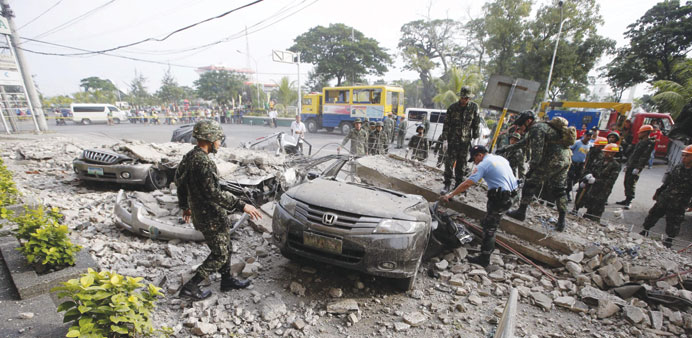Soldiers view damaged cars beneath the rubble outside a building following a 7.2-magnitude earthquake in Cebu City, central Visayas.
DPA/Manila
Lynlyn Empleo doubts she will be able to sleep tonight after experiencing a powerful earthquake that jolted her central Philippine province of Cebu.
Empleo, 26, was feeding her year-old baby when tables and chairs at home shook violently and figurines on the bookshelf crashed to the floor.
“The house was swaying and shaking at the same time,” she said. “I keep feeling the movements when I lie down and close my eyes. I think I will stay awake tonight.”
The 7.2-magnitude earthquake struck in Bohol province, 640kms south of Manila, as people had breakfast. It tore down many old buildings in Bohol and nearby Cebu, officials said.
At least 93 people died in the quake, and the death toll was expected to rise as rescuers continued search operations.
Many homes suffered cracks in walls and floors, and windows of some buildings were shattered. Roads cracked open and liquefied in some areas.
“There is a possibility that tonight no one will be able to sleep,” Cebu City Mayor Michael Rama said, noting that it was the first time the province of nearly 4mn people has been hit by a powerful earthquake.
“I saw buildings swinging,” he said. “I don’t think it will be easy for people to close their eyes tonight.”
In Bohol, thousands of residents were planning to stay out of their homes overnight.
“We are leaving our home to stay at an evacuation centre tonight,” said Antonio Seismundo, a tourist van driver residing in Lila town. “It could be dangerous at night. We’re still having a lot of strong aftershocks.”
Seismundo, 41, a father of four children, said his home’s roof caved in a little during the earthquake.
Bohol provincial Governor Edgardo Chatto said authorities were looking for temporary shelter for people afraid to return home.
“Many people are not yet comfortable to return to go back home,” he said.
Chatto also appealed to residents to keep calm amid rumours circulating that the earthquake could trigger a tsunami.
“Bohol is surrounded by islands, the possibility of a tsunami is remote,” he said.
Power lines were knocked down in Bohol, a province of more than 1.25mn people. Some areas of Cebu were also without electricity.
Manny Francisco, an editorial cartoonist from Singapore who was spending a one-month vacation with his wife in Cebu, said he was worried about food.
“We might cut our vacation short depending on the situation tomorrow,” he said. “The problem right now is we weren’t able to buy food earlier.”
Shopping malls and stores were closed while authorities inspected damage amid strong aftershocks.
Francisco said he felt the vibrations pushing him upward during the earthquake.
“I told my wife to stay at the sofa because I was thinking it would stop. But instead, the shaking became stronger,” he said. “I have experienced earthquakes before, but none this terrifying. It was very terrifying.”
Background: Worst quakes in the Philippines
The Philippines sits on the “Ring of Fire,” a belt around the Pacific Ocean where friction between shifting tectonic plates causes frequent earthquakes and volcanic activity.
According to the Philippine Institute of Volcanology and Seismology, an average of 20 earthquakes occur in the archipelago of more than 7,000 islands everyday, but most of these are too weak to be felt by people.
The following are some of the deadliest earthquakes to hit the Philippines in the past:
August 2, 1968 — A magnitude-7.3 earthquake rocked the town of Casiguran, Aurora province, 200 kilometres south-east of Manila, killing 270. Most of the victims, 268 people, were killed when a six-storey building in Manila’s Chinatown collapsed.
August 17, 1976 — The southern island of Mindanao was struck by a magnitude-7.9 earthquake that spawned a tsunami, leaving 4,791 dead and 2,288 missing presumed dead. The tremor hit just after midnight, when most people were sleeping.
July 16, 1990 — A magnitude-7.9 earthquake shook the northern island of Luzon, levelling many buildings including a hotel in the mountain resort city of Baguio. More than 1,600 people were killed and 1,000 listed as missing presumed dead. It caused damage worth 10bn pesos ($232mn).
November 15, 1994 —The island of Mindoro, just south of Manila, was struck by a magnitude-7.1 earthquake, causing a tsunami that swept away homes as people slept. The earthquake and tsunami killed 78 people and destroyed nearly 8,000 homes.
February 6, 2012 — A magnitude-6.9 earthquake hit the central province of Negros Oriental, leaving 51 dead and 62 missing. More than 383mn pesos worth of infrastructure were damaged, including 15,787 houses.
FACTS: Visayas
The central Philippine region of Visayas, which was struck by a strong earthquake yesterday, is a favourite tourist destination known for its beautiful beaches, lush tropical forests and year-long festivals.
The area, composed of three sub-regions and 16 provinces, has a population of more than 18mn people, according to 2010 data from the National Statistical Coordination Board. It has a total land area of 5.99mn hectares.
Agriculture and tourism are the top industries in Visayas, whose main islands are Cebu, Bohol, Leyte, Samar, Negros and Panay.
In the first seven months of the year, more than 1mn foreign tourists visited various destinations in Visayas, according to data from regional tourism offices. The number represents nearly a third of the 2.8mn foreign tourist arrivals in the Philippines from January to July.
The most visited areas by foreign and local tourists alike are Cebu, Bohol and Boracay island, voted among the world’s best beach destinations for its white sand.
1. Injured Filipino victims wait outside a hospital after an aftershock following the earthquake in Cebu City.



